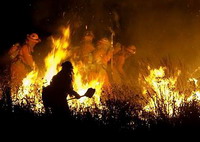Wildfires in California demand new fighting strategies
A California fire that killed five firefighters last year has emboldened those who question the cost of saving homes on the fringe of wilderness.

The five perished last fall while protecting an empty mountain vacation home from the southern California fire, which authorities say was started by a 36-year-old auto mechanic now charged with murder.
However, the deaths also were blamed on social and political pressures and decisions to put homes before the safety of firefighters, according to a report last week from the California Department of Forestry & Fire Protection.
As another fire season heats up, some U.S. Forest Service officials say a shift in strategy is inevitable as firefighters increasingly risk their lives defending communities that have been built in prime fire territory.
"We are not going to die for property," said Tom Harbour, national director of fire and aviation management for the Forest Service. "It's time for homeowners to take responsibility for the protection of their homes."
Chief Forester Gail Kimbell would not say whether the service is considering a change in policy on defending homes in certain fire conditions, but the agency plans to address flaws in the response to the deadly fire in remote Twin Pines, about 90 miles (145 kilometers) east of Los Angeles, and is conducting a longer-term review of overall firefighter safety.
Firefighters' attitudes also are an issue in protecting homes.
Public expectations can sometimes lead to bravado and a cavalier mind-set among firefighters, experts say. A recent investigative report in the five deaths listed overconfidence, excessive motivation and risk-taking as contributing factors.
"One of the standard fire orders states: 'Fight the fire aggressively having provided for safety first,"' said Peter Leschak, a 26-year firefighter and a commander for the Minnesota Department of Natural Resources' Division of Forestry. "There has been an argument recently to change that because we don't need to encourage firefighters to be more aggressive - half the time we're holding them back."
Federal firefighters could scale back structural protection without too much political fallout, but that would not be easy for the California Department of Forestry and Fire Protection, which answers to the governor, said John Maclean, a federally certified firefighter and the author of several books on wildfire disasters.
The state agency spends 44 percent of its budget on wildfire suppression annually, he said, and much of that work means protecting homes where suburbs collide with wilderness.
More than 6 million homes in California stand in wildfire "red zones" - defined as .... - and that number is expected to grow by 20 percent in the next decade.
"There is an expectation on the part of a lot of people that somebody better get in there and do or die for their house," Maclean said. "If you stop doing that and you stop taking reasonable risk to protect structures, you'd have a new governor in about five minutes."
David Kassel, who rebuilt his San Diego home after it burned in 2003, said he would be shocked if firefighters started backing off structural protection.
"What is the purpose of the fire department? Are they just going to stand around and watch?" Kassel said. "If the structures are being left to the local departments to take care of, isn't that simply shifting the risk from one department to another? I wouldn't want to be the fireman who would say, 'I'm going to leave this to you because we can't handle something risky."'
Subscribe to Pravda.Ru Telegram channel, Facebook, RSS!




